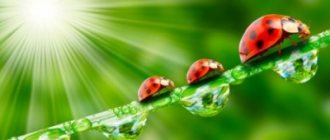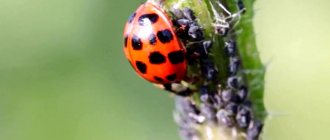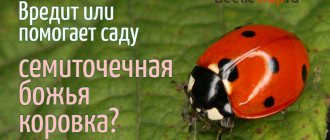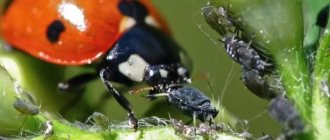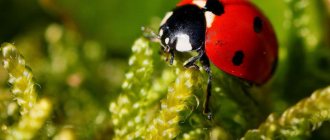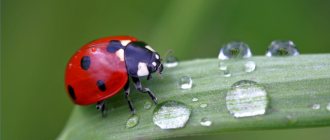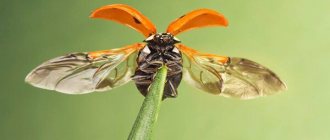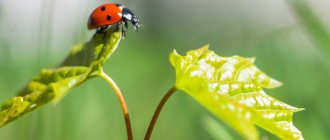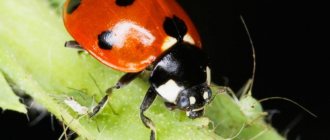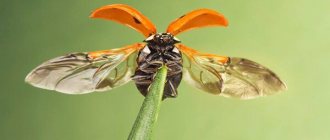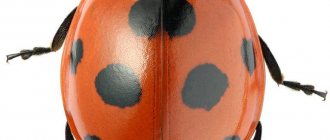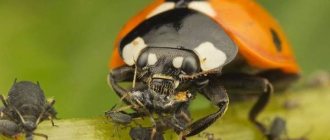Black eresus (Eresus kollari) is a poisonous spider with a unique appearance. It is also sometimes called "black fathead". This species belongs to the Eresidae family. Spider bites are dangerous for both people and pets. It is necessary to take into account that black eresus is listed in the Red Book, so killing the arachnid is strictly not recommended.
Eresus black or black fathead, appearance
What does an eresus spider look like: photo
Eresus: ladybug spider.
Description of the Erasus spider
Name: Eresus or Black fathead Lat.:
Eresus kollariClass: Arachnida - Arachnida Order: Spiders - Araneae Family: Eresidae - Eresidae
| Habitats: | dry steppes and deserts |
| Dangerous for: | insects and small arachnids |
| Attitude towards people: | They don’t harm, but they bite painfully. |
Are you afraid of spiders?
TerribleNo
The size of the female individual is from 8 to 18 mm. The body is compact and round with short thick legs. The color is velvety black. Small light hairs are present. Males have a body length of 6 to 8 mm. The color is very bright. The cephalothorax is black with sparse light hairs. The hairs form the basis of white narrow rings.
The belly has a rounded shape. In the upper part it is painted bright red. In this area there are 4 black spots, similar in appearance to a button. The bottom and sides are black. The hind two pairs of paws may be spotted with red.
Safe types
Safe species of spiders in Russia hunt insects, waiting for a long time for prey to fall into the net. Their bites are not dangerous for humans. These species live not only in nature; many live in courtyards and settle next to people in their homes.
Safe types of spiders in Russia include the following varieties:
- brownies;
- orb weavers;
- argiope;
- knitters.
People do not like spiders because in their homes they weave webs into hidden and visible areas of walls and ceilings. But in nature, creatures are beneficial and maintain the natural balance, so there is no need to fight them.
House spiders
This species prefers outbuildings and human habitation for its habitat. Preys on moths, bedbugs, cockroaches and other small insects. In nature, dense grass or a crack in tree bark serves as housing. The variety spreads evenly throughout Russia.
External signs of a house spider:
- the body is colored yellow with a brown tint; there is a brown pattern on the surface of the back;
- spider size is from 0.7 to 1.2 cm, females are always larger;
- The legs are colored darker than the body, their length is approximately 2 times the size of the body.
The web in dark areas of an apartment or house has the shape of a funnel. The owner waits for prey in the center of the net; when an insect hits, the spider deals with it with lightning speed.
Orb weaver in nature
The species lives in tree crowns, nets are placed between the branches, and the leaves are used to make shelters. Wheel-shaped traps immediately attract attention in a forest or garden. Sometimes round nets are placed under the eaves, in the window frames of abandoned houses.
The poison is toxic to invertebrates and small vertebrates; it affects rats, rabbits, mice, but horses, dogs, guinea pigs and sheep do not react to the bite. The locust's muscles lock up after 35 minutes, and the frog stops moving within 15 minutes. When bitten, a person experiences mild pain, but the volume of injected poison remains safe.
Orb weavers have an increased appetite and eat up to 8 insects at one time. If there is prey that is unacceptable to it in the trap, then the owner breaks off the web around it and the insect falls. It does network cleaning in the same way.
Argiope arthropods
Arachnids of this species are not dangerous to large mammals and humans. Males are modest in size and rarely exceed 0.5 cm, while females grow up to 2.5−3 cm. The color of the back resembles a wasp due to its bright black and yellow stripes. Short hair grows on the chest and partly on the head. The long legs consist of several jointed sections and are black with pale yellow spots.
Argiopes are spiders of central Russia, because they prefer areas with a temperate climate. They are also found in the southern part of the Stavropol Territory. The bite of an arthropod is compared to that of a bee; spiders do not attack first and do not show aggression. A slight pain is felt at the site of the lesion, swelling appears, but everything returns to normal after 2-3 days.
Trudoviks knitters
The species is distributed throughout the Russian territory and is found more often than in other countries. They almost always prefer nature and do not live in buildings. For hunting, round nets with large rectangular cells are made. The observer sees that such a product is not suitable for fishing due to the rare threads, but it’s all about the specific victim that must fall into the net. Knitters hunt for long-legged mosquitoes, which are a favorite delicacy.
Knitter Description:
- the body has an oblong shape;
- long legs consist of segmented segments;
- many outgrowths are observed on the chelicerae;
- females are large, reaching 3 cm, but males are inferior in height.
The long body saves the knitter in case of danger. At a moment of anxiety, he stretches his legs along his body and in this position resembles a dry twig. If it is disturbed in this state, the spider quickly falls and quickly runs away.
Diet and lifestyle
The Eresus spider leads a secretive lifestyle and rarely appears on the surface of the earth. They can occupy the beetles' home, but they are also capable of digging a deep hole themselves. The nest is a web-like tube located in the ground. Basically, the black eresus lives in a hole. Females are in the shelter all the time. Only young individuals and adult males emerge from the burrows during the mating period.
Webs are a network for the victim. Future food gets caught there and gets stuck, which the female catches and prepares for consumption. Arthropods feed on:
- insects;
- beetles;
- flies;
- butterflies;
- centipedes;
- woodlice;
- scorpions;
- lizards.
Larvae
Coccinellid larvae belong to the campodeoid type - they are mobile, have an elongated body and three pairs of long thoracic legs. The appearance of the larvae of members of the family is very diverse. The larvae of most Palaearctic species belong to the so-called coccinelloid type, which is characterized by a fusiform body shape, a large head and long legs.
The head of the larvae is rounded and quadrangular, approximately the same width and length. Its sides are rounded to one degree or another or straight. There are antennae on the head. Two-segmented and single-segmented antennae are characteristic of specialized genera that feed on pseudoscale insects. Variations in the structure of the antennae are represented by a combination in different combinations of different lengths of the basal and apical segments (genus Hyperaspis
,
Nephus
).
The mandibles of the larvae are triangular or sickle-shaped, protruding or slightly protruding. Mandibles according to their structure can be divided into 2 types. The first - multi-toothed, triangular in shape, with an absent retinacula - are characteristic of species ( Subcoccinella
) with a herbivorous lifestyle. Mandibles of the second type are characteristic of Coccinellinae; they are sickle-shaped, have 1-2 sharp teeth at the apex, and the retinacula is developed. There are three simple eyes on the sides of the head. The abdomen is 10-segmented, without caudal filaments at the end. The legs are long, wider than the body. The dorsum has various structures, armed with setae, or covered with white waxy threads.
The prothorax is much longer and narrower than the mesothorax and metathorax. The dorsum of the prothorax has 2 or 4, rarely 6 scutes - square, rounded-square or elongated, placed longitudinally. The dorsum of the mesothorax and metathorax have 2 scutes of an oval oblong, less often round shape, located across the segments. On their outer edges the scutes are covered with various setae.
Legs are elongated. The abdomen is formed by 10 segments, the last of which is shifted to the ventral side and has the shape of a sucker. The tergite of segment IX is most often rounded at its apex, sometimes with a cone-shaped or triangular outgrowth. The integumentary formations on the abdomen of larvae are extremely diverse and can be used as important taxonomic characters. They are represented by: warts, outgrowths of various shapes and bristles.
The larvae go through four instars. Larvae of the first instar are small in size, length from 0.5 to 1.2-1.7 mm. At the fourth instar, the length of the larvae is 5-8 mm, and some - 17-18 mm. Larvae of the first instar usually have a single color - dark or gray with white, yellow, orange or red spots. At older ages, the larvae acquire bright and varied colors. Bright coloring is characteristic, as a rule, of species that feed on aphids and live openly in their colonies. There is a relationship between color and their behavior: the more active the larva, the brighter its color (genus Coccinella, Coccinula, Anatis
,
Harmonia axyridis
,
Aiolocaria mirabilis
, with a contrasting combination of rich black color with orange spots and stripes). Single-colored, often dark larvae are characteristic of ladybugs that feed on pseudoscale insects. The color of the larvae is subject to age and individual variability.
Beetles and larvae of most species are entomophagous predators. Only a few species eat plant foods.
Life cycle
Eresus spider black.
Males leave their burrows in search of a mate. The courtship period takes place over several hours. The males are dancing. At the same time, they form a protein liquid, which leads the female to a catalytic state. The pedipalps transport seminal fluid into the genital opening.
If there are several males, a duel begins. For 2 months after fertilization, males live in burrows with females. The female is engaged in the manufacture of a cocoon. There can be about 80 eggs in a cocoon.
The female weaves insect skin, grass, and leaves into the cocoon to disguise it. During the day she warms him under the bright rays of the sun, and at night she takes him to shelter. The lifespan of a female is 1.5 years, and a male is 8 months.
Reproduction
Puberty occurs at the age of 1-2 years. Sexually mature males go in search of potential mates after the spring urge. Having discovered a female, they settle near her shelter and patiently wait for the right moment to form a pair. As a rule, it appears in late summer or early autumn, when dry, warm weather sets in.
Ritual fights take place between males for the right to acquire family ties. The female allows the winner to sneak into her shelter and stay there until next spring. Mating occurs after the arrival of spring warmth.
The male makes his way under the female’s abdomen and, using pedipal fingers, transfers the spermatophore to her genitals, located in front of the spinnerets. While the female is in a cataleptic state, the gentleman tries to leave her home. Otherwise it may be eaten.
Soon after mating, the female weaves a cocoon up to 10 mm in size and lays 60 to 80 eggs in it. She presses him to the cephalothorax with her forelimbs and almost constantly maintains this position.
Incubation lasts 2-3 weeks. The hatched spiders gather near the mother's mouth and feed on pre-digested food. A caring mother, due to the large production of digestive enzymes, gradually turns into a nutritious pulp and dies.
They spend the winter in her hole, and in the spring they scatter in different directions. Males, as a rule, go further than females.
Eresus bites
The venom of the Eresus spider is considered strong and dangerous. The spider kills its prey in seconds. For humans, the bite is very painful, but not fatal. The spider stings painfully and injects a large portion of poison.
Black fathead.
Symptoms of a bite are:
- sharp pain;
- swelling;
- numbness of the bite site;
- strong pain.
Danger to humans
As a rule, males and young individuals do not pose a danger to humans, since they cannot bite through the skin with their weak jaws, although isolated cases of attacks are known. Adult females pose a danger, especially in July-August. You can distinguish the female by its color. Males have red spots with white rims, while females have no edging. Sometimes in females the red spots change to yellow stripes. Females have long legs up to 30 mm and are significantly larger than males.
The attack happens very quickly. Karakurt attacks only in self-defense. Nature has endowed the spider with such a strong poison so that it can capture the burrows of small rodents, which do not come into conflict with it and immediately vacate their territory. A predator can attack when it first seems to be in danger, so it is better to avoid contact with it. The difficulty in detecting danger lies in the fact that karakurts do not weave their net in the classical way. The threads are arranged horizontally, the web does not have a characteristic pattern and is chaotic. Attacks occur most often at night and on vacation, when you can accidentally crush the karakurt or disturb the web.
A spider bite is not painless, but it does not cause much concern. The bite site is marked with a small red spot, which disappears after a few minutes. After the poison has taken effect, the bitten person begins to experience severe pain in the damaged area. Specific psychological and physiological reactions arise.
In the first minutes and hours after the bite, poisoning is characterized by the following symptoms:
- strong mental agitation;
- feeling of fear of death, panic;
- spasms and suffocation;
- severe pain in the abdomen, chest and lower back;
- feeling that the legs are being taken away;
- bluish complexion;
- shallow breathing, dizziness;
- sometimes cramps of the arms and legs, tremors, vomiting;
- increased heart rate, arrhythmia;
- retention of urination and defecation;
- increased protein content in urine.
